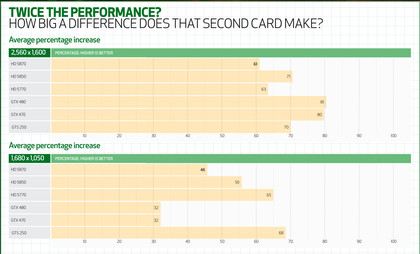SLI vs CrossFire: which is better?
What's better than one graphics card? Two, but CrossFire or SLI?
So SLI and CrossFire are really starting to make a name for themselves then. Ease of installation and the burgeoning returns you get for adding in the extra card now makes it a viable proposition.
As we can see though, it's Nvidia that has made the most gains in its multi-GPU technology in the performance sector. Both of its latest cards are hitting an average percentage frame rate increase of 80 per cent at the eye-bleeding resolution of 2,560 x 1,600.
It has conceded the lower end of the scale, garnering a pretty poor showing of 32 per cent at 1,680 x 1,050. But you're only going to be forking out for an extra £300 (or so) for a graphics card, if you're powering a monitor with a screen large enough to do it justice.
Despite putting much of its high-end emphasis on the value of its multi-GPU solution, the HD 5970, AMD hasn't quite got the same performance boost when it comes to adding in that extra card. Sure it's 5 series cards are better than the Fermis at the lower end, but only the HD 5850 manages to post percentage gains of over 70 per cent.
Where AMD can compete though is in the price/performance metrics. Since it released the 10.4 version of its Catalyst drivers the GTX 470 has taken a bit of a pounding. The HD 5770 in CrossFire is easily comparable in performance terms with the slower Fermi card, and a pair of them are also significantly cheaper. They likewise put the equivalently priced HD 5850 to shame and also manage to hit over 60 per cent average percentage gains too.

Click here to see the high-res version
Top performance though has to go to the insane numbers you get out of the GTX 480 when it's got a twin sat next to it. Still, that's nearly £1,000-worth of graphical componentry and unless you're powering three 30-inch panels they're hardly worth the cash.
Get daily insight, inspiration and deals in your inbox
Sign up for breaking news, reviews, opinion, top tech deals, and more.
But this whole multi-GPU thing is now relevant, rather than being simply a technical demo for GPU makers to show what their graphical gems are capable of, cash notwithstanding. And it's easy too.
At no point in the testing of these six different setups did I encounter any frustrating problems born of multi-GPU drivers. A simple tick-box in the relevant driver panels in Windows was all it took to get them playing nice.
On the AMD side too you're not looking at spending more cash just for the possibility of adding in a second card later on; most full size mobos these days are rocking multiple PCI-e lanes with CrossFire support.
On the Nvidia side things are a mite stickier; tracking down SLI compatible boards is a tougher ask and can be pricer too. But the future's bright and in the GTX 470's Heaven 2.0 benchmark we've actually seen the first time where adding a second card more than doubles performance.
Nvidia's dominance in the percentage increase stakes means that suddenly SLI is going to be a lot more interesting this summer when the mid-range Fermi cards tip up.
-------------------------------------------------------------------------------------------------------
First published in PC Format Issue 241
Liked this? Then check out 15 best graphics cards in the world today
Sign up for TechRadar's free Weird Week in Tech newsletter
Get the oddest tech stories of the week, plus the most popular news and reviews delivered straight to your inbox. Sign up at http://www.techradar.com/register